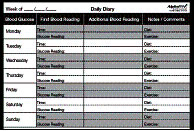For yourself[]

This diabetes diary from AlphaTrak is an example of a place to record information about your dog's diabetes.
Thorough record keeping provides an invaluable tool for both you and your vet to determine the needs of your sugar pet. Without good records you won't see the "whole picture" of how your dog is doing or whether and increase/decrease may be in order. Accurate data will also give you a reference of how your dog reacts to doses, feedings and times of day.
It's good to have a Diabetic Log book for your diabetic dog. It should contain everything needed to maintain up to date information. One suggestion is to purchase a hard surface 3 ring binder that has a pocket on each cover. On the front inside pocket to clip a business card for your vet as well as your local emergency clinic. In a crisis it is handy to know where these are. On the front you might insert a picture of your dog and the title Diabetic Log Book. The picture of your dog could be handy for a pet sitter, etc. to know without a doubt who they are caring for.
List of items you should have in your Log Book
- BG Log Some glucometer manufacturers also provide logging software, such as this free software from LifeScan, [1] the manufacturer of the One Touch meters
- Curve Log
- Vet information
- Emergency Clinic Information
- Insulin Type/Manufacturer/Ordering Info (+script if necessary)
- Syringe Type/Ordering Info (+script if necessary)
- Most recent lab results
- Hypo
- BG interpretation guidelines
- Pet sitter information
- Blank pages for notes
The curve article discusses recording blood glucose numbers and completing a curve graph.
For emergencies[]
Having a card with information on it in the area with your driver's license stating you have a diabetic pet at home, possibly with some individual care information on it would be great. In cases of accident/illness away from home, the driver's license is ALWAYS checked for your ID, in case you're unable to ID yourself.
At home, it's good to keep a current sheet of information in your personal phone book, with the sheet being long enough for it to be seen when the book is closed. (Paramedics & police check this out, looking for medical & family contact information for you, if you can't give it yourself.) It should mention that your pet is an Insulin-dependent diabetic, what his daily dosages are, when they are to be given, what he eats and how much, etc.
Include instructions on how to find you, or an alternate person who knows how to care for the animal. For example, my instructions were to take him to the hospital (address & phone) during office hours and to page (pager #) John (who would then come to get him) after hours. In case something happened to me and I was not going to be able to care for him temporarily, I was then satisfied that he would be cared for properly by those he knew, liked and trusted.
The sheet also said where to find the insulin, where to find his syringes, and to take insulin AND syringes with him to the hospital.
For alternate caregivers[]
You may need to be away from your diabetic pet for any number of reasons; the length of your absence may be only a few hours or it could be for days or weeks. While some people opt to board their diabetic pet with their veterinarian, others choose to hire a caregiver for the time they are away from home. The use of a checklist makes it easier for the person who is responsible for the pet while you are away and gives you peace of mind that you have put everything that's necessary for that person to know in writing.![]() [2]
[2]
References[]
- ↑ Free Software. LifeScan.
- ↑ Pet Sitter Checklist. Merck.
More Information[]
- Vetsulin Online Glucose Curve Generator Intervet
This online generator will also allow you to print the results out. It does NOT send any of the information you enter back to Intervet. Please note that since this is a US-based website, all values will be shown in US measurements. There is no online generator for the product under the Caninsulin name to provide non-US measurements, but there is an Excel program you can download here: - Caninsulin Curve Plotting Program Intervet
Note: this is an Excel file. Immediately on clicking the link, you'll be asked if you want to open or save the file. The program is geared for mmol/L measurement values. - Glucose Curve Worksheet Intervet
- Glucose Curve Interpretation Intervet
- Treatment Monitoring Sheet Intervet
- Blood Glucose Curve Plotting Template Gorbzilla
Note--these are Excel files and there's a choice of mg/dl (US) values or mmol/L (rest of the world) values. - AlphaTrak Diabetes Diary Abbott Animal Health
You need not be an AlphaTrak owner to use this recordkeeping pdf. - Pet Owner's Log from BD Diabetes.
Record for blood and urine glucose tests, appetite and insulin injections.